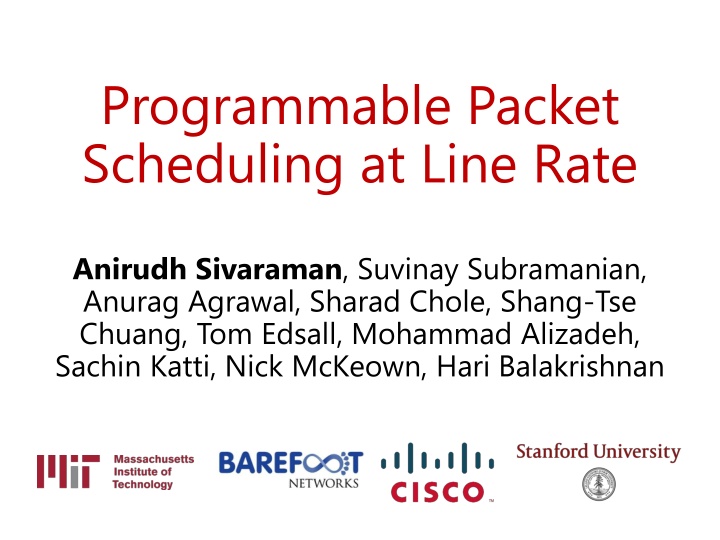
Programmable Packet Scheduling at Line Rate for Enhanced Network Efficiency
Explore the challenges and solutions in programmable packet scheduling at line rate, including the complexities of scheduling algorithms, abstractions, and order computations to improve network performance and efficiency.
Download Presentation

Please find below an Image/Link to download the presentation.
The content on the website is provided AS IS for your information and personal use only. It may not be sold, licensed, or shared on other websites without obtaining consent from the author. If you encounter any issues during the download, it is possible that the publisher has removed the file from their server.
You are allowed to download the files provided on this website for personal or commercial use, subject to the condition that they are used lawfully. All files are the property of their respective owners.
The content on the website is provided AS IS for your information and personal use only. It may not be sold, licensed, or shared on other websites without obtaining consent from the author.
E N D
Presentation Transcript
Programmable Packet Scheduling at Line Rate Anirudh Sivaraman, Suvinay Subramanian, Anurag Agrawal, Sharad Chole, Shang-Tse Chuang, Tom Edsall, Mohammad Alizadeh, Sachin Katti, Nick McKeown, Hari Balakrishnan
Programmable scheduling at line rate Programmable: Can we express a new scheduling algorithm? Line-rate: Highest capacity supported by a communication standard
Programmability at line-rate Ingress Pipeline Parser Egress Pipeline Scheduler Deparser Stage 1 Match Stage N Match Action Stage N Match Action Stage 1 Match Action Eth Action Match Action Match Action Match Action Match Action IP TCP Match Action Match Action Match Action Match Action OpenFlow: Match-Action interface, fixed fields, fixed actions P4, RMT, FlexPipe, Xpliant: Protocol-independent match- action pipeline.
Why is programmable scheduling hard? Plenty of scheduling algorithms Yet, no consensus on the right abstractions for scheduling In contrast to Parse graphs for parsing Match-Action tables for forwarding
The Push-In First-Out Queue Many algorithms determine transmission order at packet arrival Relative order of packet transmissions of packets in the queue doesn t change with future arrivals Examples: SJF: Order determined by flow size FCFS: Order determined by arrival time Push-in first-out queues (PIFO): packets are pushed into an arbitrary location based on a priority, and dequeued from the head First used as a proof construct by Chuang et. al
A programmable scheduler Ingress Pipeline Scheduler Classification & Transmission Order Computation Classification & Transmission Order Computation Push-In-First-Out (PIFO) Queue
pFabric using PIFO Scheduler 1. f = flow(p) 2. p.prio = f.rem_size Push-In-First-Out (PIFO) Queue
Weighted Fair Queuing Ingress Pipeline Scheduler 1. 2. 3. 4. f = flow(p) p.start = T[f].finish T[f].finish = p.start + p.len / p.w p.prio = p.start Push-In-First-Out (PIFO) Queue
Traffic Shaping Ingress Pipeline Scheduler 1. update tokens 2. p.send = now + (p.len - tokens) / rate; 3. p.prio =p.send Push-In-First-Out (PIFO) Queue
Composing PIFOs Composing PIFOs Hierarchical packet-fair queueing (HPFQ) PIFO-root (WFQ on A and B) A BA B A A (0.5) B (0.5) 1 2 2 4 3 4 (0.7) 1 (0.1) 2 (0.9) 3 (0.3) PIFO-A (WFQ on 1 and 2) PIFO-B (WFQ on 3 and 4)
The PIFO abstraction PIFO: A sorted array that let us insert an entry (packet or PIFO pointer) into a PIFO based on a programmable priority Entries are always dequeued from the head If an entry is a packet, dequeue and transmit it If an entry is a PIFO, dequeue it, and continue recursively
PIFO in hardware Range search CAM Mini-PIFO bank 128 elements MiniPIFO Min Max 1 10 100 300 500 1000 1 10 100 300 500 1000 10 100 300 500 1000 2000 10 100 300 500 1000 2000 1000 mini-PIFOs Meets timing at 1 GHz on a 16 nm node 5 % area overhead for 3-level hierarchy Challenges wisdom that sorting is hard
Closing thoughts Line-rate programmable scheduling is within reach Two concrete benefits Program new scheduling algorithms Design and verify a PIFO, not many scheduling algorithms
